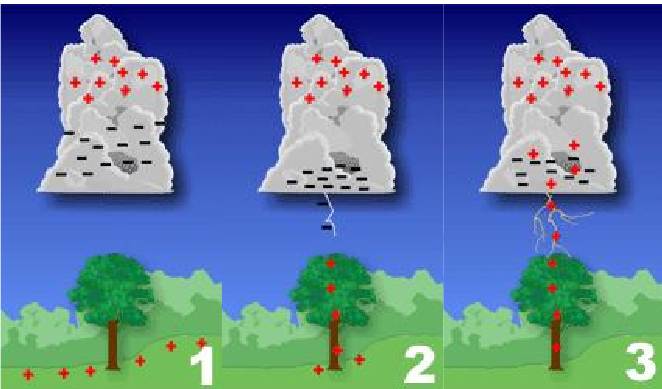How Lightning is Created
The conditions needed to produce lightning have been known for some time. However, exactly how lightning forms has never been verified so there is room for debate. Leading theories focus around separation of electric charge and generation of an electric field within a thunderstorm. Recent studies also indicate that ice, hail, and semi-frozen water drops known as graupel are essential to lightning development. Storms that fail to produce large quantities of ice usually fail to produce lightning.
Forecasting when and where lightning will strike is not yet possible and most likely never will be. But by educating yourself about lightning and learning some basic safety rules, you, your family, and your friends can avoid needless exposure to the dangers of one of the most capricious and unpredictable forces of nature.
Charge Separation

Thunderstorms have very turbulent environments. Strong updrafts and downdrafts occur with regularity and within close proximity to each other. The updrafts transport small liquid water droplets from the lower regions of the storm to heights between 35,000 and 70,000 feet, miles above the freezing level.
Meanwhile, downdrafts transport hail and ice from the frozen upper regions of the storm. When these collide, the water droplets freeze and release heat. This heat in turn keeps the surface of the hail and ice slightly warmer than its surrounding environment, and a “soft hail”, or “graupel” forms. When this graupel collides with additional water droplets and ice particles, a critical phenomenon occurs:
Electrons are sheared off of the ascending particles and collect on the descending particles. Because electrons carry a negative charge, the result is a storm cloud with a negatively charged base and a positively charged top.
Field Generation
In the world of electricity, opposites attract and insulators inhibit. As positive and negative charges begin to separate within the cloud, an electric field is generated between its top and base. Further separation of these charges into pools of positive and negative
regions results in a strengthening of the electric field.
However, the atmosphere is a very good insulator that inhibits electric flow, so a TREMENDOUS amount of charge has to build up before lightning can occur. When that charge threshold is reached, the strength of the electric field overpowers the atmosphere’s insulating properties, and lightning results.
The electric field within the storm is not the only one that develops. Below the negatively charged storm base, positive charge begins to pool within the surface of the earth (see image left). This positive charge will shadow the storm wherever it goes, and is responsible for cloud-to-ground lightning. However, the electric field within the storm is much stronger than the one between the storm base and the earth’s surface, so most lightning (~75-80%) occurs within the storm cloud itself.
How Lightning Develops Between The Cloud And The Ground
A moving thunderstorm gathers another pool of positively charged particles along the ground that travel with the storm (image 1). As the differences in charges continue to increase, positively charged particles rise up taller objects such as trees, houses, and telephone poles.

A channel of negative charge, called a “stepped leader” will descend from the bottom of the storm toward the ground (image 2). It is invisible to the human eye, and shoots to the ground in a series of rapid steps, each occurring in less time than it takes to blink your eye. As the negative leader approaches the ground, positive charge collects in the ground and in objects on the ground.
This positive charge “reaches” out to the approaching negative charge with its own channel, called a “streamer” (image 3). When these channels connect, the resulting electrical transfer is what we see as lightning. After the initial lightning stroke, if enough charge is leftover, additional lightning strokes will use the same channel and will give the bolt its flickering appearance.
